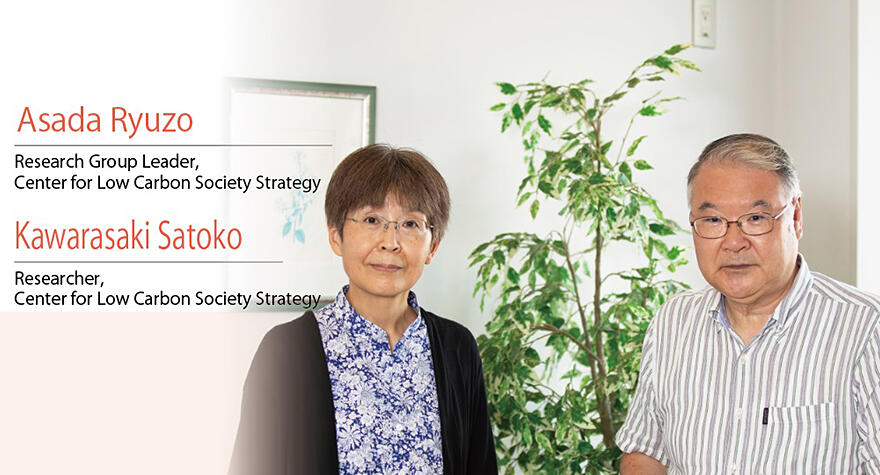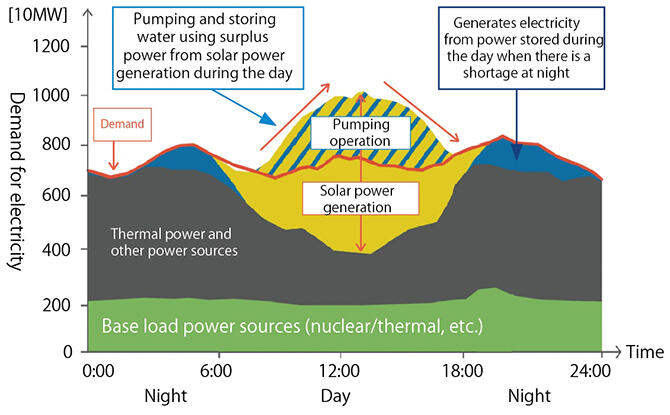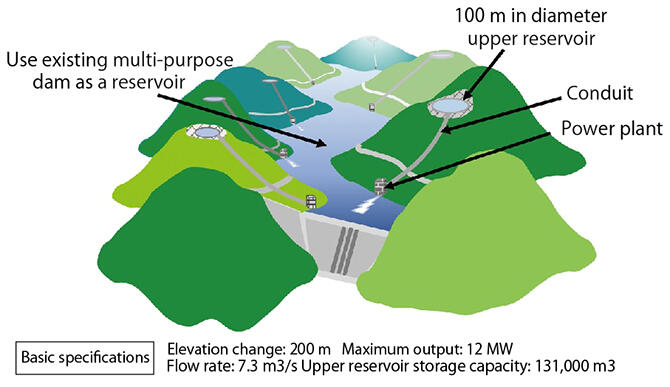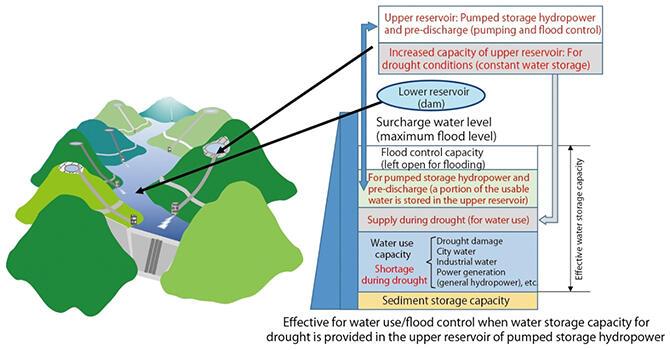
This is the fifth installment of a series of stories in which Yutaka Minagawa, a young employee of a trading company, reads and analyzes proposal papers from the Center for Low Carbon Society Strategy (LCS). In the previous instalment, Mr. Minagawa learned about power generation mix scenarios for 2050 from LCS researchers Toshihiro Inoue and Makoto Furuki. In this installment, he asked Research Group Leader Ryuzo Asada and Researcher Satoko Kawarasaki, who are researching innovative pumped storage hydropower as a power storage system at LCS, about the transition to renewable energy.
Power storage and regulation functions essential for expanding renewable energy
Minagawa: Today, I would like to talk about a new proposal called "innovative pumped storage hydropower."
Asada: Thank you for your interest in our work. Before we begin, are you familiar with pumped storage hydropower?
Minagawa: Yes, I am. It's where you generate electricity by using surplus electricity to pump water up into a holding reservoir, and when there is not enough electricity, you release the water into a lower reservoir to turn a turbine and generate electricity, right?
Asada: Exactly! It has been used in Japan since the beginning of the Showa period (1926-1989) as "storage batteries" for storing electricity. Coal-fired and nuclear power generation cannot be easily stopped, so we use excess power to pump water so we can generate electricity when we need it. This reduces overall fuel costs. For example, solar power generation generates excess power during the day when the weather is good, so this surplus power is used to pump water to generate electricity when it becomes cloudy and power generation slows down or stops at night. This allows us to use surplus power effectively and carefully adjust the supply and demand of electricity (Figure 1).
Figure 1. Example of a future pumped storage hydropower application

(https://www.jst.go.jp/lcs/pdf/webinar20220624-7.pdf)
Minagawa: It is true that solar and wind power generation are unstable and subject to weather conditions, so if they are to expand in the future, it will be necessary to have a function to regulate power.
Asada: Although the need for pumped storage hydropower plants is increasing, it is no longer feasible to build large power plants that change the landscape, and it also takes a long time to construct them. So, we then considered the possibility of creating a relatively small one. This is small-scale, decentralized "new pumped-storage hydropower generation."
Using an existing multi-purpose dam that is small-scale, low-cost, and has minimal environmental impact
Asada: Pumped storage hydropower requires a pair of upper and lower reservoirs, but if an existing multi-purpose dam is used as a lower reservoir, only an additional upper reservoir needs to be constructed, which we thought would have less of an environmental impact and lower construction costs (Figure 2).
Figure 2. Overview of innovative pumped storage hydropower

Minagawa: I see! So, you are using an existing dam rather than building a power plant from scratch.
Asada: There are 2,700 multipurpose dams in Japan, and so they can be constructed in a distributed manner throughout the country. The upper reservoir is small, 100 meters in diameter, and is built at a height of at least 200 meters above the lower reservoir. I checked the number of multi-purpose dams that meet these criteria and found less than 1,000 nationwide.
Minagawa: Is that so? Maybe that's because of Japan's mountainous terrain. By the way, how did you do your research? You didn't go to see all the dams, did you?
Asada: No, no, we used a map to identify candidate sites and worked with Ms. Kawarasaki to divide the sites into eastern and western Japan. Still, it took me two to three months.
Kawarasaki: We looked up the location of the dam in "Dams in Japan" published by the Japan Dam Foundation, overlaid that with a map from the Geospatial Information Authority of Japan, and examined whether there was a 200-meter change in elevation in the surrounding area, whether the distance from the lower reservoir was within 1,500 meters, and whether an upper reservoir with a diameter of 100 meters could be built. We also avoided areas with nature parks and areas prone to landslides.
Minagawa: That sounds like a very thorough process. Assuming you have a good location, what kind of construction would you actually do to build it?
Asada: The upper reservoir will be 10 meters deep. From there, a conduit would be run to the lower reservoir, where a power station would be built, and a generator would be installed. A single upper reservoir can produce a 10,000-kilowatt power plant. The lowest construction cost per plant is estimated to be 2.1 to 2.2 billion yen, and the average is 2.7 billion yen.
Minagawa: I have heard that it costs several hundred billion yen to build a dam. However, if you build a new facility in the middle of nature, would you be subject to criticism that it is environmentally destructive?
Asada: Of course, we would. However, the scale of the project is extremely small, and it can be said to improve the environment through flood control measures and the fact that the road for dam management can be used as a forestry road to manage isolated mountains.
Minagawa: So, you are proposing other benefits as well. By the way, what do you mean by flood control?
"Regulation" is the key to their spread other than effective technology for flood protection and drought measures in the event of a disaster
Asada: A multi-purpose dam releases some of its stored water in advance of a flood. That's fine if it rains as forecast, but if it doesn't, all that water will be wasted.
Minagawa: There are so many conflicts over water, and the rights holders would be furious if we wasted it.
Asada: On the other hand, with the innovative pumped storage hydropower system, if you know that a flood is coming, you can pump water into the upper reservoir in advance and let it flow slowly into the lower reservoir after the flood is over. The water is simply raised and lowered, so none of it is wasted. The upper reservoir can be deepened to 20 meters to store water for droughts (Figure 3).
Figure 3. Example of water storage capacity allocation

Minagawa: It is also attractive because it allows us to prevent flooding and drought without wasting water. I think a lot of people would be interested in this proposal.
Asada: Yes, we have received some inquiries from companies, but our idea is to get city and prefectural governments to act. Since there are a lot of water rights holders at the dam, it is up to the local government or other entity that manages the dam to coordinate these rights. There is also the matter of coordination with the owner of the land on which the upper reservoir will be built. In some places, the owners of the conduit are different from each other, and in other places, the owners are no longer known, so it has become necessary to revise the law so that the local government can take custody of the land.
Kawarasaki: Whether installing solar panels or geothermal power generation, we are stuck with the same problem of land ownership, so it is time for a major rethink.
Asada: For municipalities, the first step is to draw a blueprint for how they want to achieve de-carbonization for the region as a whole, and if they increase solar and wind power generation, they will naturally need to have an energy storage function. Moreover, there is a dam in their area. If the site is suitable for innovative pumped storage hydropower, the question is how to budget and realize the project since there is no technical hurdle.
Minagawa: Many municipalities are now aiming to decarbonize by 2050, so if we can coordinate systems and budgets to match their visions, it is likely to spread.
Asada: If we are going to make renewable energy the main source of power, we will definitely need a power regulation function. If a model case can be developed successfully and then horizontally deployed throughout the country, more and more of them may emerge. If the regions are networked, they can also share surplus power to pump water according to weather conditions. Theoretically, this is feasible, since solar and wind power potentials are scattered throughout the country.
Minagawa: If we can successfully coordinate non-technical aspects, I have high expectations for the realization of this project! We will be keeping a close eye on future developments.
* This is a fictional narrative based on an interview.
(Text: Akane Iwasaki, Photos: Hideki Ishihara)





